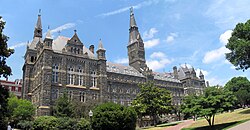Healy Hall
|
Healy Hall
|
|
 |
|
| Location | Georgetown University, Washington, D.C. |
|---|---|
| Coordinates | 38°54′26.07″N 77°4′22.73″W / 38.9072417°N 77.0729806°WCoordinates: 38°54′26.07″N 77°4′22.73″W / 38.9072417°N 77.0729806°W |
| Built | 1877-79 |
| Architect | Smithmeyer and Pelz |
| Architectural style | Neo-Medieval |
| NRHP Reference # | 71001003 |
| Significant dates | |
| Added to NRHP | May 25, 1971 |
| Designated NHL | December 23, 1987 |
Healy Hall is a National Historic Landmark located at the main campus of Georgetown University. Constructed between 1877-79, the hall was designed by Paul J. Pelz and John L. Smithmeyer, prominent architects who also built the Library of Congress. The structure was named after Patrick Francis Healy, who was the President of Georgetown University at the time.
Healy Hall serves as the main administrative and reception venue of Georgetown, with some portions still being used as classrooms. The building includes the Riggs Library, one of the few extant cast iron libraries in the nation, as well as the elaborate Gaston Hall.
The building was built during the presidency of Patrick Francis Healy after whom it is named.
The construction of the building, from 1877 to 1879, dramatically increased the amount of classroom and living space - at the time it was also used as a dormitory - of what was then a small liberal arts college. The construction also left the university deeply in debt and in possession for years of an enormous pile of dirt as a result of the excavation, with no funds to remove it. As a result of the debts, the Gaston Hall auditorium could not be completed until 1909.
The building was listed on DC Inventory of Historic Sites in 1964, on the National Register of Historic Places on May 25, 1971, and as a National Historic Landmark on December 23, 1987.
The building was brought to national attention in 1973 when it acted as a prominent background for the film The Exorcist. In 1990 the interior hall and also the second story of the building featured in The Exorcist III.
...
Wikipedia



